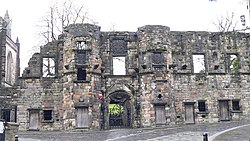Mar's Wark
| Mar's Wark | |
|---|---|

East façade of Mar's Wark at the head of Broad Street
|
|
| Location | St John Street, Stirling, Scotland |
| Coordinates | 56°07′16″N 3°56′39″W / 56.1211°N 3.9441°WCoordinates: 56°07′16″N 3°56′39″W / 56.1211°N 3.9441°W |
| Built | 1572 |
| Built for | John Erskine, Earl of Mar |
|
Listed Building – Category A
|
|
| Designated | 4 November 1965 |
| Reference no. | 41348 |
| Designated | 1999 |
| Reference no. | 90289 |
|
Location of Mar's Wark in Stirling council area
|
|
Mar's Wark is a ruined building in Stirling built 1570–1572 by John Erskine, Regent of Scotland and Earl of Mar, and now in the care of Historic Scotland. Mar intended the building for the principal residence of the Erskine family in Stirling, whose chief had become hereditary keeper of the nearby royal Stirling Castle where the princes of Scotland were schooled. is a Scots language word for work, and here it means building. The house is also called "Mar's Lodging."
The building fronts the kirk yard of the Holy Rude Church and sits at the head of the processional route to Stirling Castle above the town's tollbooth. The windowless front façade survives lacking its upper storey, access is possible to the first floor. The basement vaults have doors and windows to the street and may have been intended for shops.
The façade is nearly symmetrical around a gatehouse frontispiece with two polygonal towers. Liberal carved stone decoration is based on European print-sources or decorative arts with royal and Erskine heraldry, and wry inscriptions. A motif of the letter "A" with the earl's coronet points to a variant version of the family name, as "Areskine," or possibly the initial of Mar's countess, Annabella Murray. Traditionally it has been alleged that the carvings include stones re-cycled from Cambuskenneth Abbey.
The general articulation and architectural mouldings closely reflect royal buildings, especially the palace at Stirling Castle. The Earl of Mar may well have called upon the skills of the royal Master of Work to the Crown of Scotland of the time, William MacDowall.
The Wark is now protected by the Scottish Government as a category A-listed building, and as a scheduled monument.
...
Wikipedia

